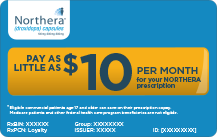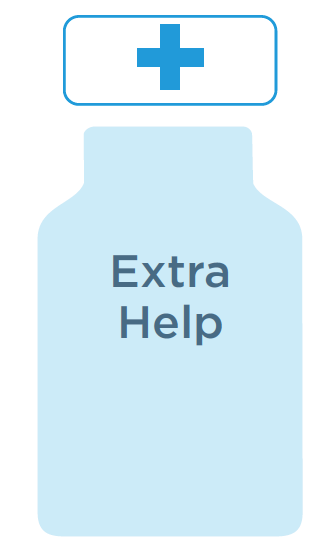NORTHERA® (droxidopa) stands by you and your patients every step of the way, so you can feel confident you can help maintain their treatment with patient access support offerings.
NORTHERA Commercial Copay Assistance Program
Commercially insured patients age 17 and older with a valid NORTHERA prescription may be eligible for copay assistance through the NORTHERA Commercial Copay Assistance Program*

- Patients are not eligible for this assistance if they are uninsured or if the prescription is eligible to be reimbursed, in whole or in part, by any state or federal health care programs, including but not limited to Medicare or Medicaid, Medigap, VA, DOD, or TRICARE
- Patients must pay at least $10 for each 30-day prescription. Copay assistance is available as allowed by individual states†
- A maximum benefit limit may also apply; patients should confirm their out-of-pocket cost with their specialty pharmacy
*See complete Terms and Conditions for the Commercial Copay Assistance Program.
†Certain states may not allow commercial copay support if a generic product is available. Please check the policies in your prescribing state for compliance.
Medicare Part D - coverage
Assistance is available when you prescribe NORTHERA
Medicare Part D provides prescription drug coverage for Medicare patients. Part D coverage is optional. Patients need to enroll in a Medicare Prescription Drug Plan or a Medicare Advantage Plan to take advantage of Part D benefits.1‡ Medicare payers may require a prior authorization (PA) or step therapy.2
Every Part D plan is different, and many elements can impact a patient’s prescription costs3§
Below are 2 resources that may allow eligible Part D patients to lower their costs4
- Plans that provide supplemental coverage during the coverage gap||
- State Pharmaceutical Assistance Programs
Any information regarding Medicare Part D plans is not intended to imply disease prevalence or appropriate patients for treatment with NORTHERA; Lundbeck is not providing this information to influence HCPs’ independent medical judgments regarding patients for whom NORTHERA may be appropriate.
‡Coverage may be subject to PA or trial and failure of prior therapy. Lundbeck does not control the Medicare program and does not make any guarantees with regard to coverage or Medicare plan terms.
§HCPs and patients are responsible for complying with applicable plan requirements, and may want to contact a plan directly to confirm its specific requirements.
||The coverage gap (“donut hole”) is a phase of Medicare Part D plans that begins after the total costs spent by both the patient and health plan reach a certain threshold.3
Medicare Part D – Extra Help
Eligible Medicare Part D patients may be able to access NORTHERA at a low cost
“Extra Help” with prescription drug costs
Medicare Part D’s Extra Help, also known as the Low-Income Subsidy (LIS) program, assists patients with limited income or resources by covering some or most of their Medicare prescription drug costs.

With Extra Help, patients can receive:
- Prescription drug coverage
- Pay a lower deductible (or none at all)
- Receive a lower required cost share during the coverage gap and the catastrophic coverage phases
Lundbeck does not control the Medicare or LIS programs and does not make any guarantees with regard to coverage, Medicare Part D plan terms, or the LIS program. Any information about the LIS program is not intended to imply disease prevalence or appropriate patients for treatment with NORTHERA.
Lundbeck does not control the Medicare or LIS programs and does not make any guarantees with regard to coverage, Medicare Part D plan terms, or the LIS program. Any information about the LIS program is not intended to imply disease prevalence or appropriate patients for treatment with NORTHERA.
Qualifying for Extra Help
Patients who are “dual eligible” (qualify for both Medicare and Medicaid), or who receive Supplemental Security Income, are automatically enrolled in Extra Help. Others can apply for Extra Help by1:
Visiting1: SocialSecurity.gov
Calling Social Security1 at 1-800-772-1213
Eligibility for full or partial Extra Help benefits is based on their income and assets in relation to the federal poverty level.
This information is subject to change. Medicare and LIS are not Lundbeck programs, and Lundbeck is not guaranteeing the availability or details of LIS or any Medicare plan. The programs and Part D plans have many nuances that are not necessarily reflected on this website. These nuances could impact program eligibility and coverage details for individual patients.
Commercial insurance
Coverage for medications, including NORTHERA, varies from plan to plan5
Commercial insurance may be available to help patients pay for their medications. Please note the following:
- Not all commercial plans include prescription coverage
- Some plans require that patients use an ”in-network” pharmacy when filling prescriptions
- HCPs and patients are responsible for complying with applicable plan requirements and may want to contact a plan directly to confirm its specific requirements
- Commercial payers may require PA or step therapy

References:
1. Centers for Medicare & Medicaid Services. https://www.medicare.gov/Pubs/pdf/10050-Medicare-and-You.pdf. Accessed June 23, 2021. 2. MMIT on Medicare Patients. July 14, 2021 data. Accessed July 20, 2021. 3. Centers for Medicare & Medicaid Services. Your Guide to Medicare Prescription Drug Coverage. https://www.medicare.gov/media/4621. Accessed April 12, 2021. 4. Centers for Medicare & Medicaid Services. 6 ways to lower your coverage gap costs. https://www.medicare.gov/part-d/costs/coverage-gap/ways-to-lower-drug-costs.html. Accessed March 26, 2019. 5. MMIT on Commercial Patients. July 14, 2021 data. Accessed July 20, 2021. 6. NORTHERA [package insert]. Deerfield, IL: Lundbeck. 7. Freeman R. N Engl J Med. 2008;358(6).615-624.
Please see Important Safety Information, including Boxed Warning for supine hypertension.
For more information, see the full Prescribing Information.
Indications and Usage
NORTHERA (droxidopa) is indicated for the treatment of orthostatic dizziness, lightheadedness, or the “feeling that you are about to black out” in adult patients with symptomatic neurogenic orthostatic hypotension (nOH) caused by primary autonomic failure (Parkinson’s disease [PD], multiple system atrophy, and pure autonomic failure), dopamine beta-hydroxylase deficiency, and non-diabetic autonomic neuropathy. Effectiveness beyond 2 weeks of treatment has not been established. The continued effectiveness of NORTHERA should be assessed periodically.
Important Safety Information
WARNING: SUPINE HYPERTENSION
Monitor supine blood pressure prior to and during treatment and more frequently when increasing doses. Elevating the head of the bed lessens the risk of supine hypertension, and blood pressure should be measured in this position. If supine hypertension cannot be managed by elevation of the head of the bed, reduce or discontinue NORTHERA.
CONTRAINDICATIONS
- NORTHERA is contraindicated in patients who have a history of hypersensitivity to the drug or its ingredients.
WARNINGS AND PRECAUTIONS
- Supine Hypertension: NORTHERA therapy may cause or exacerbate supine hypertension in patients with nOH, which may increase the risk of cardiovascular events if not well managed, particularly stroke.
- Hyperpyrexia and Confusion: Cases of a symptom complex resembling neuroleptic malignant syndrome (NMS) have been reported with NORTHERA use during post-marketing surveillance. Observe patients carefully when the dosage of NORTHERA is changed or when concomitant levodopa is reduced abruptly or discontinued, especially if the patient is receiving neuroleptics. NMS is an uncommon but life-threatening syndrome characterized by fever or hyperthermia, muscle rigidity, involuntary movements, altered consciousness, and mental status changes. The early diagnosis of this condition is important for the appropriate management of these patients.
- Ischemic Heart Disease, Arrhythmias, and Congestive Heart Failure: NORTHERA therapy may exacerbate existing ischemic heart disease, arrhythmias, and congestive heart failure. Careful consideration should be given to this potential risk prior to initiating therapy.
- Allergic Reactions: Hypersensitivity reactions, including anaphylaxis, angioedema, bronchospasm, urticaria, and rash have been reported in post-marketing experience, with some resulting in emergency treatment. If a hypersensitivity reaction occurs, discontinue the drug and initiate appropriate therapy.
- This product contains FD&C Yellow No. 5 (tartrazine), which may also cause allergic-type reactions (including bronchial asthma) in certain susceptible persons. Although the overall incidence of FD&C Yellow No. 5 (tartrazine) sensitivity in the general population is low, it is frequently seen in patients who also have aspirin hypersensitivity.
ADVERSE REACTIONS
- The most common adverse reactions (>5% and ≥3% difference compared to placebo) were headache, dizziness, nausea, and hypertension.
DRUG INTERACTIONS
- Administering NORTHERA in combination with other agents that increase blood pressure (e.g., norepinephrine, ephedrine, midodrine, and triptans) would be expected to increase the risk for supine hypertension.
- Dopa-decarboxylase inhibitors may require dose adjustments for NORTHERA.
- The concomitant use of selective MAO-B inhibitors, such as rasagiline or selegiline, was permitted in the NORTHERA clinical trials. However, based on mechanism of action, the use of non-selective MAO inhibitors and linezolid should be avoided as there is a potential for increased blood pressure when taken with NORTHERA.
USE IN SPECIFIC POPULATIONS
- There are no available data on use of NORTHERA in pregnant women and risk of major birth defects or miscarriage. Because of the potential for serious adverse reactions, including reduced weight gain in breastfed infants, advise a woman not to breastfeed during treatment with NORTHERA.
- The safety and effectiveness of NORTHERA in pediatric patients have not been established. No overall differences in safety or effectiveness were observed between patients aged 75 years and older and younger patients in clinical trials, but greater sensitivity of some older individuals cannot be ruled out.
- Clinical experience with NORTHERA in patients with severe renal function impairment (GFR <30 mL/min) is limited; therefore, dosing recommendations cannot be provided for these patients.
For more information, please see the full Prescribing Information, including Boxed Warning for supine hypertension.


